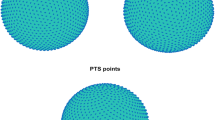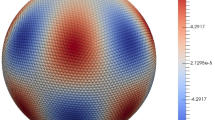Abstract
In this paper, a meshless approximation based on generalized moving least squares is applied to solve the reaction–diffusion equations on the sphere and red-blood cell surfaces. The proposed method is based on the projected gradient of the shape functions, and it approximates the Laplace operator defined on the surfaces that is called Laplace–Beltrami. This technique only requires nodes at locations on the surface and the corresponding normal vectors to the surface. To discretize the time variable, an explicit time technique based on the fourth-order Runge–Kutta is used. Some numerical results on Turing and Fitzhugh–Nagumo partial differential equations are given for showing patterns which are appeared in biological phenomena.

Taken from Kondo and Miura (2010)

Taken from Cherry and Fenton (2008)






Similar content being viewed by others
References
Adomian G (1995) The diffusion Brusselator equation. Comput Math Appl 29:1–3
Alford JG, Auchmuty G (2006) Rotating wave solutions of the FitzHugh–Nagumo equations. J Math Biol 53(5):797–819
Ang WT (2003) The two-dimensional reaction–diffusion Brusselator system: a dual-reciprocity boundary element solution. Eng Anal Bound Elem 27:897–903
Bergdorf M, Sbalzarini I, Koumoutsakos P (2010) A Lagrangian particle method for reaction–diffusion systems on deforming surfaces. J Math Biol 61:649–663
Bertalmio M, Cheng L, Osher S, Sapiro G (2001) Variational problems and partial differential equations on implicit surfaces. J Comput Phys 174:759–780
Calhoun DA, Helzel C (2009) A finite volume method for solving parabolic equations on logically Cartesian curved surface meshes. SIAM J Sci Comput 31(6):4066–4099
Cherry EM, Fenton FH (2008) Visualization of spiral and scroll waves in simulated and experimental cardiac tissue. New J Phys 10:125016
Chertock A, Kurganov A (2008) A second-order positivity preserving central-upwind scheme for chemotaxis and haptotaxis models. Numer Math 111:169–205
Cooper SB, Van Leeuwen J (2013) Alan Turing: his work and impact. Elsevier, Atlanta
Chiu C, Yu JL (2007) An optimal adaptive time-stepping scheme for solving reaction–diffusion–chemotaxis systems. Math Biosci Eng 4(2):187–203
Dehghan M, Abbaszadeh M (2016) The use of element-free Galerkin method based on moving Kriging and radial point interpolation techniques for solving some types of Turing models. Eng Anal Bound Elem 62:93–111
Dehghan M, Fakhar-Izadi F (2011) Pseudospectral methods for Nagumo equation. Int J Numer Methods Biomed Eng 27:553–561
Epshteyn Y, Kurganov A (2008) New interior penalty discontinuous Galerkin methods for the Keller–Segel chemotaxis model. SIAM J Numer Anal 47:386–408
Fasshauer GE (2007) Meshfree approximation methods with MATLAB. World Scientific, Hackensack
Fitzhugh R (1961) Impulses and physiological states in theoretical models of nerve membrane. Biophys J 1:445–466
Fua H, Guoa H, Houb J, Zhao J (2016) A stabilized mixed finite element method for steady and unsteady reaction–diffusion equations. Comput Methods Appl Mech Eng 304:102–117
Fuselier EJ, Wright GB (2013) A high-order kernel method for diffusion and reaction–diffusion equations on surfaces. J Sci Comput 56:535–565
Gambino G, Lombardo MC, Sammartino M (2013) Pattern formation driven by cross-diffusion in a 2D domain. Nonlinear Anal. RWA. 14:1755–1779
Gierer A, Meinhardt H (1972) A theory of biological pattern formation. Kybernet 12:30–39
Gomatam J, Amdjadi F (1997) Reaction–diffusion equations on a sphere: meandering of spiral waves. Phys Rev E 56:3913–3919
Gray P, Scott SK (1983) Autocatalytic reactions in the isothermal, continuous stirred tank reactor: Isolas and other forms of multistability. Chem Eng Sci 38:29–43
Guin LN, Mandal PK (2014) Effect of prey refuge on spatiotemporal dynamics of the reaction–diffusion system. Comput Math Appl 68:1325–1340
Guin LN, Haque M, Mandal PK (2012) The spatial patterns through diffusion-driven instability in a predator-prey model. Appl Math Model 36:1825–1841
Guin LN (2015) Spatial patterns through Turing instability in a reaction–diffusion predator-prey model. Math Comput Simul 109:174–185
Hodgkin Huxley A (1952) A quantitative description of membrane current and its application to conduction and excitation in nerve. J Physiol 117:500–544
Ilati M, Dehghan M (2015) Meshless local weak form method based on a combined basis function for numerical investigation of Brusselator model and spike dynamics in the Gierer–Meinhardt system. Comput Model Eng Sci (CMES) 109:325–360
Ilati M, Dehghan M (2017) Application of direct meshless local Petrov–Galerkin (DMLPG) method for some Turing-type models. Eng Comput 33:107–124
Islam SU, Ali A, Haq S (2010) A computational modeling of the behavior of the two-dimensional reaction–diffusion Brusselator system. Appl Math Model 34:3896–3909
Izhikevich EM (2010) Hybrid spiking models. Philos Trans R Soc A 368:5061–5070
Kondo S, Iwashita M, Yamaguchi M (2009) How animals get their skin patterns: fish pigment pattern as a live Turing wave. Int J Dev Biol 53:851–856
Kondo S, Miura T (2010) Reaction–Diffusion model as a framework for understanding biological pattern formation. Science 329:1616–1620
Kostova T, Ravindran R, Schonbek M (2004) Fitzhugh–Nagumo revisited: types of bifurcations, periodical forcing and stability regions by a lyapunove functional. Int J Bifurcat Chaos 14:913–925
Lancaster P, Salkauskas K (1981) Surfaces generated by moving least squares methods. Math Comput 37:141–158
Lehto E, Shankar V, Wright GB (2017) A radial basis function (RBF) compact finite difference (FD) scheme for reaction–diffusion equations on surfaces. SIAM J Sci Comput 39(5):2129–2151
Lengyel I, Epstein IR (1991) Modeling of Turing structures in the chlorite-iodidemalonic acid-starch reaction system. Science 251:650–652
MacDonald CB, Ruuth SJ (2009) The implicit closest point method for the numerical solution of partial differential equations on surfaces. SIAM J Sci Comput 31:4330–4350
Maini PK, Woolley TE, Baker RE, Gaffney EA, Lee SS (2012) Turing’s model for biological pattern formation and the robustness problem. Interface Focus 2:487–496
Mirzaei D (2016) Error bounds for GMLS derivatives approximations of Sobolev functions. J Comput Appl Math 294(1):93–101
Mirzaei D (2017) Direct approximation on spheres using generalized moving least squares. BIT Numer. Math. 57:1041–1063
Mirzaei D, Schaback R, Dehghan M (2012) On generalized moving least squares and diffuse derivatives. IMA J Numer Anal 32(3):983–1000
Mittal RC, Jiwari R (2011) Numerical study of two-dimensional reaction–diffusion Brusselator system by differential quadrature method. Int J Comput Methods Eng Sci Mech 12:14–25
Mohammadi M, Mokhtari R, Schaback R (2014) Simulating the 2D Brusselator system in reproducing kernel Hilbert space. Comput Model Eng Sci 101:113–138
Mosekilde E (1996) Topics in nonlinear dynamics: applications to physics, biology and economic systems. World Scientific, London
Murray JD (1993) Mathematical biology. Springer, Heidelberg
Nagumo J, Arimoto S, Yoshizawa S (1962) An active pulse transmission line simulating nerve axon. Proc. IRE 50:2061–2070
Nomura T, Glass L (1996) Entrainment and termination of reentrant wave propagation in a periodically stimulated ring of excitable media. Phys. Rev. E. 53:6353–6360
Peng Y, Zhang T (2016) Turing instability and pattern induced by cross-diffusion in a predator-prey system with Allee effect. Appl. Math. Comput. 275:1–12
Piret C (2012) The orthogonal gradients method: a radial basis functions method for solving partial differential equations on arbitrary surfaces. J. Comput. Phys. 231(20):4662–4675
Prigogine I, Lefever R (1968) Symmetry breaking instabilities in dissipative systems II. J. Chem. Phys. 48:1695–1700
Quarteroni A, Sacco R, Saleri F (2007) Numerical mathematics. Springer, New York
Roqoreanu C, Georgescu A, Giurgiteanu N (2000) The FitzHugh–Nagumo model: Bifurcation and dynamics. Springer, New York
Ruuth SJ, Merriman B (2008) A simple embedding method for solving partial differential equations on surfaces. J Comput Phys 227:1943–1961
Salehi R, Dehghan M (2013) A generalized moving least square reproducing kernel method. J Comput Appl Math 249:120–132
Schnakenberg J (1979) Simple chemical reaction system with limit cycle behavior. J Theor Biol 81:389–400
Sekimura T, Madzvamuse A, Wathen A, Maini P (2000) A model for colour pattern formation in the butterfly wing of Papilio dardanus. Proc R Soc Lond Ser B 26:852–859
Selkov EE (1968) Self-oscillations in glycolysis. Eur J Biochem 4:79–86
Shakeri F, Dehghan M (2011) The finite volume spectral element method to solve Turing models in the biological pattern formation. Comput Math Appl 62:4322–4336
Shankar V, Wright GB, Fogelson AL, Kirby RM (2015) A radial basis function (RBF)-finite difference (FD) method for diffusion and reaction–diffusion equations on surfaces. J Sci Comput 63:745–768
Sheth R, Marcon L, Bastida MF, Junco M, Quintana L, Dahn R, Kmita M, Sharpe J, Ros M (2012) Hox genes regulate digit patterning by controlling the wavelength of a Turing-type mechanism. Science 338:1476–1480
Smiely M (2009) An efficient implementation of a numerical method for a chemotaxis system. Int J Comput Math 86:219–235
St Clair NM (2006) Pattern formation in partial differential equations, Thesis
Sugai SS, Ode KL, Ueda HR (2017) A design principle for an autonomous post-translational pattern formation. Cell Rep 19:863–874
Tatari M, Kamranian M, Dehghan M (2011) The finite point method for reaction–diffusion systems in developmental biology. Comput Model Eng Sci CMES 82:1–27
Tonnelier A (2002) The Mckean’s caricature of the Fitzhugh–Nagumo model I. The space-clamped system. SIAM J Appl Math 63:459–484
Turing AM (1952) The chemical basis of morphogenesis. Phil Trans R Soc Ser B 237(641):37–72
Twizell EH, Gumel AB, Cao Q (1999) A second-order scheme for the ”Brusselator” reaction–diffusion system. J Math Chem 26:297–316
Tyson R, Lubkin S, Murray J (1999) Model and analysis of chemotactic bacterial patterns in a liquid medium. J Math Biol 38:359–375
Tyson R, Stern L, LeVeque R (2000) Fraction step methods applied to a chemotaxis model. J Math Biol 41:455–475
Van der Pol B, Van der mark J (1928) The heart beat considered as a relaxation oscillation, and an electrical model of the heart. Philos Mag 6:763–775
Varvruska T (2015) Turing patterns and butterfly wings. Thesis, Carroll university
Wazwaz AM (2000) The decomposition method applied to systems of partial differential equations and to the reaction–diffusion Brusselator model. Appl Math Comput 110:251–264
Wendland H (2005) Scattered Data Approximation. Cambridge University Press
Xu B, Binczak S, Jacquir S, Pont O, Yahia H (Aug 2014) Parameters analysis of FitzHugh–Nagumo model for a reliable simulation. 36th Annual international conference of the IEEE engineering in Medicine and Biology Society (EMBC’14) Chicago. United States, IEEE, p 2014
Zhu J, Zhang YT, Newman SA, Alber M (2009) Application of discontinuous Galerkin methods for reaction-diffusion systems in developmental biology. J Sci Comput 40:391–418
Acknowledgements
The authors are very grateful to reviewer for carefully reading this paper and for his (her) comments and suggestions which have improved the paper.
Author information
Authors and Affiliations
Corresponding author
Additional information
Communicated by Abimael Loula.
Rights and permissions
About this article
Cite this article
Dehghan, M., Narimani, N. Approximation of continuous surface differential operators with the generalized moving least-squares (GMLS) method for solving reaction–diffusion equation. Comp. Appl. Math. 37, 6955–6971 (2018). https://doi.org/10.1007/s40314-018-0716-1
Received:
Revised:
Accepted:
Published:
Issue Date:
DOI: https://doi.org/10.1007/s40314-018-0716-1
Keywords
- Generalized moving least-squares approximation
- Projected gradient of the shape functions
- Runge–Kutta time discretization
- Turing and Fitzhugh–Nagumo models
- Biological pattern formation
- Spot and stripe patterns
- Spiral wave patterns in excitable media




